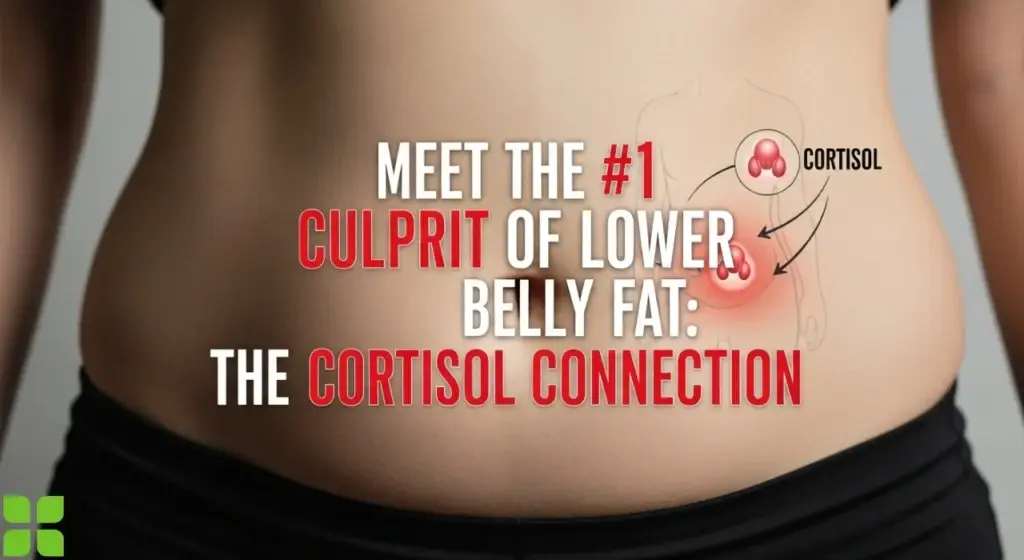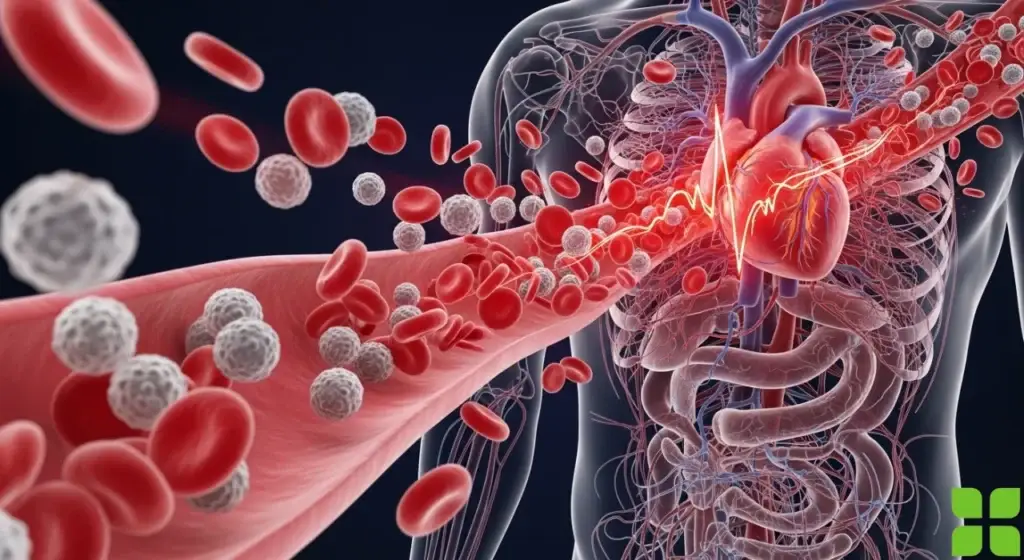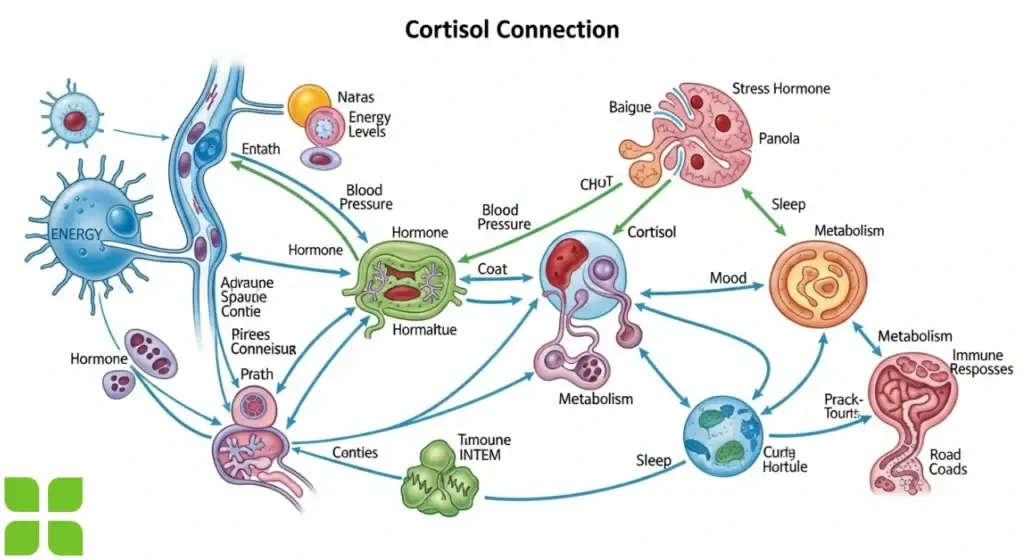Meet the #1 Culprit of Lower Belly Fat: The Cortisol Connection

You’re doing everything “right.(Lower Belly Fat)” You’ve cleaned up your diet, you’re hitting the gym, and you’ve done more crunches than you can count. Yet, that stubborn layer of lower belly fat—that soft, persistent “pouch”—refuses to budge. It’s frustrating, demoralizing, and feels like a battle you’re destined to lose.
But what if the enemy isn’t the calorie count on your plate or the number of reps you perform? What if the real culprit is a silent saboteur working from within?
Meet cortisol, your body’s primary stress hormone. While essential for survival, this powerful chemical messenger can become the master architect of stubborn abdominal fat when its delicate balance is thrown off. It’s time to move beyond the crunches and understand the hormonal story unfolding in your midsection.
Jump To…
The Body’s Alarm System Gone Haywire

Think of cortisol as your body’s built-in emergency broadcast system. When faced with a genuine threat—a predator in ancient times, a swerving car today—your adrenal glands pump out cortisol. This triggers a cascade of physiological changes designed for immediate survival:
- It floods your body with glucose (sugar), providing instant energy for your muscles to fight or flee.
- It heightens your focus and alertness.
- It momentarily stops non-essential processes like reproduction and digestion.
In a short-term crisis, this system is brilliant. The problem? Our modern lives have rewired this ancient system. The “threats” are no longer a saber-toothed tiger; they’re an overflowing inbox, financial worries, traffic jams, negative self-talk, and the 24/7 news cycle.
Your body doesn’t differentiate between a physical threat and a psychological one. It just hears the alarm. The result is chronic stress, where the cortisol tap is left constantly dripping, and that’s where the belly fat connection begins.
Related:How To Lose Belly Fat Fast
Why the Lower Belly Fat? The Science of Hormonal Fat Storage

So, why does this hormonal flood specifically target your abdomen? The answer lies in cellular biology.
The fat cells in your abdominal region, particularly the deep visceral fat that surrounds your organs, have four times more cortisol receptors than fat cells elsewhere in your body.
Let’s break down the sinister process:
Constant Stress Signal: Your brain perceives chronic stress (work, lack of sleep, poor diet).
Cortisol Release: The adrenal glands continually release cortisol.
Blood Sugar Spike: Cortisol tells your liver to release glucose for energy you never actually use (you’re not running from a predator at your desk).
Insulin to the Rescue: To clear this excess sugar from your blood, your pancreas releases insulin, the body’s primary storage hormone.
Targeted Fat Storage: Insulin and cortisol work together like a devious duo. Your belly fat cells’ high concentration of cortisol receptors enthusiastically clings to the fat when it is mobilized by cortisol, storing it for an unfulfilled “emergency” in the future.
This process specifically encourages the storage of visceral fat, the moistest dangerous types of body fat. It’s not the pinchable, subcutaneous fat just under the skin; it’s the metabolically active fat that wraps around your vital organs, increasing your risk for heart disease, diabetes, and other chronic illnesses.
This is why someone can be relatively thin elsewhere but still carry a “cortisol belly.” It’s a direct sign that their internal stress system is in overdrive.
Unmasking Your Hidden Cortisol Triggers
Before you can tame cortisol, you have to identify what’s provoking it. It’s not always the obvious stressors. Here are the silent saboteurs you might be overlooking:
The Blood Sugar Rollercoaster: A diet high in refined carbs and sugar sends your blood sugar soaring, then crashing. Your body generates cortisol to balance it after interpreting this crash as a warning sign—a mini-famine. Cravings, crashes, and cortisol are all exacerbated by this.
Overtraining (Yes, Too Much Exercise): The “more is better” mentality is a trap. Long-duration, high-intensity cardio sessions without adequate rest and recovery are a massive physical stressor. Your body doesn’t know you’re on a treadmill; it just knows it’s being pushed to its limits for an hour, and it pumps out cortisol accordingly.
Sleep Deprivation: This is non-negotiable. Cortisol has a natural rhythm: high in the morning to wake you up and low at night to let you sleep. Skimping on sleep disrupts this rhythm, leaving cortisol elevated when it should be low. This not only encourages fat storage but also increases cravings for high-sugar, high-fat foods the next day.
The Blue Light Effect: Scrolling on your phone in bed does more than keep you awake. The blue light suppresses melatonin (your sleep hormone) and can dysregulate your circadian rhythm, directly impacting your cortisol cycle.
Hidden Inflammation: Poor gut health, food intolerances, and chronic low-grade inflammation from processed foods are all perceived by your body as internal stressors, keeping the cortisol drip active.
How to Rewire Your Cortisol Connection: A New Game Plan

Tackling a cortisol belly isn’t about more punishment; it’s about more intelligence. You need to send your body a powerful new message: “You are safe.”
Get rid of the never-ending crunches and use this hormonally conscious strategy:
1.Master Your Morning:
Avoid letting your phone cause a cortisol rise at the beginning of the day. Instead, spend the first hour after waking up in the sun for ten to fifteen minutes. For the duration of the day, this helps stabilize your circadian rhythm and control your natural cortisol curve.
2.Exercise Smarter, Not Harder:
Swap chronic cardio for a balanced routine.
- Prioritize Strength Training (2-3x/week): Building muscle improves insulin sensitivity, helping your body manage blood sugar more effectively.
- Embrace Low-Intensity Movement: Walking, gentle yoga, and stretching are powerful tools for lowering cortisol and activating your parasympathetic (rest-and-digest) nervous system.
- Use HIIT Strategically: Keep High-Intensity Interval Training short (15-20 minutes max) and limit it to 1-2 times a week, ensuring you’re well-rested.
3.Eat to Stabilize, Not to Spike:
Build every meal around the “PFF” principle: Protein, Fat, and Fiber. This combination slows down digestion and prevents the blood sugar spikes and crashes that trigger cortisol release. Ditch the sugary snacks and opt for nuts, seeds, avocado, or Greek yogurt.
4.Implement the “Micro-Pause”:
You don’t need an hour of meditation. Throughout your day, take 60-second breaks to practice box breathing: Inhale for 4 seconds, hold for 4, exhale for 4, and hold for 4. This simple act can instantly halt the stress response in its tracks.
5.Create a Digital Sunset:
Declare a screen-free curfew 90 minutes before bed. This allows melatonin to rise naturally and cortisol to fall. Read a physical book, take a warm bath with Epsom salts (rich in magnesium, which calms the nervous system), or listen to calming music.
The Takeaway
That stubborn lower belly fat is more than an aesthetic issue; it’s a flashing red light on your body’s dashboard, signaling that your internal alarm system is overwhelmed. By understanding the cortisol connection, you can finally stop fighting a losing battle against your own biology.
It’s time to shift your focus from punishing your body to supporting it. By managing your stress, stabilizing your blood sugar, moving mindfully, and prioritizing rest, you can finally tame the cortisol beast and send your body the signal it’s been waiting for—the signal to let go.








One thought on “Meet the #1 Culprit of Lower Belly Fat: The Cortisol Connection”